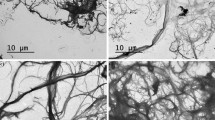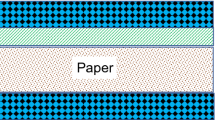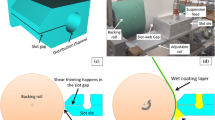Abstract
The preparation of microfibrillar cellulose (MFC) films by filtration on a polyamide filter cloth, in a dynamic sheet former and as a surface layer on base paper is described. Experimental evidence of the high tensile strength, density and elongation of films formed by MFC is given. Typically, a MFC film with basis weight 35 g/m2 had tensile index 146 ± 18 Nm/g and elongation 8.6 ± 1.6%. The E modulus (17.5 ± 1.0 GPa) of a film composed of randomly oriented fibrils was comparable to values for cellulose fibres with a fibril angle of 50°. The strength of the films formed in the dynamic sheet former was comparable to the strength of the MFC films prepared by filtration. The use of MFC as surface layer (0–8% of total basis weight) on base paper increased the strength of the paper sheets significantly and reduced their air permeability dramatically. FEG-SEM images indicated that the MFC layer reduced sheet porosity, i.e. the dense structure formed by the fibrils resulted in superior barrier properties. Oxygen transmission rates (OTR) as low as 17 ml m−2 day−1 were obtained for films prepared from pure MFC. This result fulfils the requirements for oxygen transmission rate in modified atmosphere packaging.









Similar content being viewed by others
References
Abe K, Iwamoto S, Yano H (2007) Obtaining cellulose nanofibres with a uniform weight of 15 nm from wood. Biomacromolecules 8:3276–3278. doi:10.1021/bm700624p
Ackerman P, Jägerstad M, Ohlsson T (eds) (1997) Foods and packaging materials. Chemical interactions. The Royal Society of Chemistry, Cambridge
Alava M, Niskanen K (2006) The physics of paper. Rep Prog Phys 69:669–723. doi:10.1088/0034-4885/69/3/R03
Andresen M, Stenius P (2007) Water-in-oil emulsions stabilized by hydrophobized microfibrillated cellulose. J Dispersion Sci Technol 28(5):837–844. doi:10.1080/01932690701341827
Andresen M, Johansson L-S, Tanem BS, Stenius P (2006) Properties and characterization of hydrophobized microfibrilated cellulose. Cellulose 13:665–677. doi:10.1007/s10570-006-9072-1
Andresen M, Stenstad P, Møretrø T, Langsrud S, Syverud K, Johansson L-S et al (2007) Nonleaching antimicrobial films prepared from surface-modified microfibrillated cellulose. Biomacromolecules 8(7):2149–2155. doi:10.1021/bm070304e
Bruce DM, Hobson RN, Farrent JW, Hepworth DG (2005) High-performance composites from low-cost plant primary cell walls. Compos Part A 26:1486–1493. doi:10.1016/j.compositesa.2005.03.008
Cox HL (1952) The elasticity and strength of paper and other fibrous materials. Br J Appl Phys 3(3):72–79. doi:10.1088/0508-3443/3/3/302
Dodson CTJ, Herdman PT (1982) Mechanical properties of paper. In: Rance HF (ed) Handbook of paper science 2, the structural and physical properties of paper. Elsevier, Amsterdam, pp 108–109
Dufresne A, Cavaillé J-Y, Vignon MR (1998) Mechanical behaviour of sheets prepared from sugar beet cellulose microfibrils. J Appl Polym Sci 64(6):1185–1194. doi:10.1002/(SICI)1097-4628(19970509)64:6<1185::AID-APP19>3.0.CO;2-V
Eriksen Ø, Gregersen ØW, Syverud K (2008) The effect of MFC on handsheet surface and printing properties. In: Proceedings, progress in paper physics seminar, June 2–5, Espoo, Finland
Fellers C, Norman B (1996) Pappersteknik. Avdelingen för Pappersteknik, Kungl Tekniska Högskolan, Stockholm. ISBN: 91-7170-741-7, TABS-Tryckeri AB i Småland, 292 pp
Fendler A, Villanueva MP, Giminez E, Lagarón JM (2007) Characterization of the barrier properties of composites of HDPE and purified cellulose fibres. Cellulose 14:427–438. doi:10.1007/s10570-007-9136-x
Fengel D, Grosser D (1976) Holz, “Morphologie und Eigenschaften”. In: Ullmanns Encyklopädie der technischen Chemie, 4th edn, vol 12. Verlag Chemie, Weinheim, pp 669–679
Fink H-P, Weigel P, Purz HJ, Ganster J (2001) Structure formation of regenerated cellulose materials from NMMO-solutions. Prog Polym Sci 26:1473–1524. doi:10.1016/S0079-6700(01)00025-9
Henriksson M, Berglund L (2007) Structure and properties of cellulose nanocomposite films containing melamine formaldehyde. J Appl Polym Sci 106:2817–2824. doi:10.1002/app.26946
Khopade AJ, Jain NK (1990) A stable multiple emulsion system bearing isoniazid: preparation and characterization. Drug Dev Ind Pharm 24(3):289–293. doi:10.3109/03639049809085622
Kjellgren H, Engström G (2006) Influence of base paper on the barrier properties of chitosan-coated paper. Nordic Pulp Pap Res J 21(5):685–689. doi:10.3183/NPPRJ-2006-21-05-p685-689
Krochta JM, Baldwin EA, Nisperos-Carriedo MO (eds) (1994) Edible coatings and films to improve food quality. TECHNOMIC Publishing, Lancaster
Lagaron JM, Catalá R, Gavara R (2004) Structural characteristics defining high barrier properties in polymeric materials. Mater Sci Technol 20:1–7. doi:10.1179/026708304225010442
López-Rubio A, Lagaron JM, Ankerfors M, Lindström T, Nordqvist D, Mattozzi A et al (2007) Enhanced film forming and film properties of amylopectin using micro-fibrillated cellulose. Carbohydr Polym 68(4):718–727. doi:10.1016/j.carbpol.2006.08.008
Malainine ME, Mahrouz M, Dufresne A (2005) Thermoplastic nanocomposites based on cellulose microfibrils from Opuntia ficus-indica parenchyma cell. Compos Sci Technol 65:1520–1526. doi:10.1016/j.compscitech.2005.01.003
Nakagaito AN, Yano H (2005) Novel high-strength biocomposites based on microfibrillated cellulose having nano-order-unit web-like network structure. Appl Phys A 80:155–159. doi:10.1007/s00339-003-2225-2
Ougiya H, Watanabe K, Morinaga Y, Yoshinaga F (1997) Emulsion-stabilizing effect of bacterial cellulose. Biosci Biotechnol Biochem 61:1541–1545
Oza KP, Frank SGJ (1986) Microcrystalline cellulose stabilized emulsions. J Dispersion Sci Technol 7:543–561. doi:10.1080/01932698608943478
Pääkkö M, Ankerfors M, Kosonen H, Nykänen A, Ahola S, Österberg M et al (2007) Enzymatic hydrolysis combined with mechanical shearing and high-pressure homogenization for nanoscale cellulose fibrils and strong gels. Biomacromolecules 8(3):1934–1941. doi:10.1021/bm061215p
Page DH, El-Hosseiny F, Winkler K, Lancaster APS (1977) Elastic modulus of single wood pulp fibres. Tappi J 60(4):114–117
Parry RT (1993) Principles and applications of modified atmosphere packaging of foods. Chapman & Hall, Suffolk
Stenstad P, Andresen M, Tanem BS, Stenius P (2008) Chemical modifications of microfibrillated cellulose. Cellulose 15(1):35–45. doi:10.1007/s10570-007-9143-y
Taniguchi T (1998) New films produced from microfibrillated natural fibres. Polym Int 47:291–294. doi:10.1002/(SICI)1097-0126(199811)47:3<291::AID-PI11>3.0.CO;2-1
Turbak AF, Snyder FW, Sandberg KR (1983) Microfibrillated cellulose, a new cellulose product: properties, uses, and commercial potential. J Appl Polym Sci Appl Polym Symp 37:815–827
Acknowledgements
The authors gratefully acknowledge Södra Cell, Borregaard Industries, Akzo Nobel and the NANOMAT programme of the Research Council of Norway for funding. Olav Solheim (PFI) is thanked for data processing and Øyvind Gregersen (NTNU) and Øyvind Eriksen for valuable discussions. Per Olav Johnsen is acknowledged for acquiring the images.
Author information
Authors and Affiliations
Corresponding author
Rights and permissions
About this article
Cite this article
Syverud, K., Stenius, P. Strength and barrier properties of MFC films. Cellulose 16, 75–85 (2009). https://doi.org/10.1007/s10570-008-9244-2
Received:
Accepted:
Published:
Issue Date:
DOI: https://doi.org/10.1007/s10570-008-9244-2




